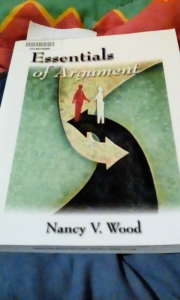
(Essentials of Argument, by Nancy Wood)
This is another review in the series on critical thinking. So, far, it is the 4th article.
Here are the previous entries on the topic:
CLICK HERE, for #1, Honest v. Dishonest Debate Tactics.
CLICK HERE, for #2, Logical Self Defense.
CLICK HERE, for #3, Critical Thinking for Dummies.
Why do we spend so much time on the topic of critical thinking? Because understanding the law depends (at least theoretically), on understanding the creation and reasoning behind it. The more we know about that, the more in depth we can go, and either apply the law, or lobby to have it changed.
Hence, it is the skill itself that is essential, not necessarily the individual arguments themselves.
This book is different in that is has a largely academic undertone to it. Being able to research and analyse issues for classroom and presentations is a large theme of it. A main focus is writing persuasive and well reasoned essays.
The Wood book also goes through screening and selecting authors for their work, and trying to compare their findings with comparable authors. A lot of time is spent trying to break down opinions and express them clearly, and in a well reasoned manner.
It makes a great deal of sense. If one is writing a school essay, or a Master’s thesis, or PhD. dissertation, coherent reasoning is essential. You wouldn’t want the people reviewing your work to claim that it is illogical or makes no sense.
Further, the book gives examples of strengthening your own arguments, while attempting to fend off opposing arguments, or reasoning that could commonly be used to rebut your claims.
As with other books, there is also a section (Pages 147-150) about logical fallacies, such as:
(a) Begging the question (lacks evidence);
(b) Red herring (irrelevant and misleading evidence);
(c) Non sequitur (it does not follow);
(d) Straw man (mischaracterising someone’s arguments);
(e) Stacked evidence
(f) Either-Or;
(g) Post-hoc
(h) Generalization
(I) Ad Hominem
(j) Guilt by association
(k) Using authority instead of evidence
(l) Bandwagon appeal
(m) Slippery slope
(n) Creating false needs
This is part of the list that would also be found in the Reed website, which is almost exclusively devoted to dishonest debate tactics. Here, Ms. Wood has a small section on them.
A Brief Outline of The Book
Chapter 1: Recognizing argument and finding issues
Chapter 2: The rhetorical situation
Chapter 3: Research into issues
Chapter 4: Writing exploratory papers
Chapter 5: Toulmin model for argument (parts)
Chapter 6: Types of Claims
Chapter 7: Types of Proof
Chapter 8: Writing the research paper
Chapter 9: Writing the Rogerian argument paper
Chapter 10: Visual and oral argument
There is a fairly interesting topic near the end regarding presentations. This can be applied to both school and work settings. It gives guidelines for how to set up clear and logical presentations without being overwhelming, a useful skill to have.
My only real criticism of this book is that for the most part, it is an exceptionally dry read. To be fair, there isn’t much that can be done to make it exciting. But while it is dry and rather dull, the information presented is quite valuable, especially to students and academics in general.
Nonetheless, devoted students would find it worthwhile.
Discover more from Canuck Law
Subscribe to get the latest posts sent to your email.
